Channel surfing
Concentrated water flow creates king-friendly scenario
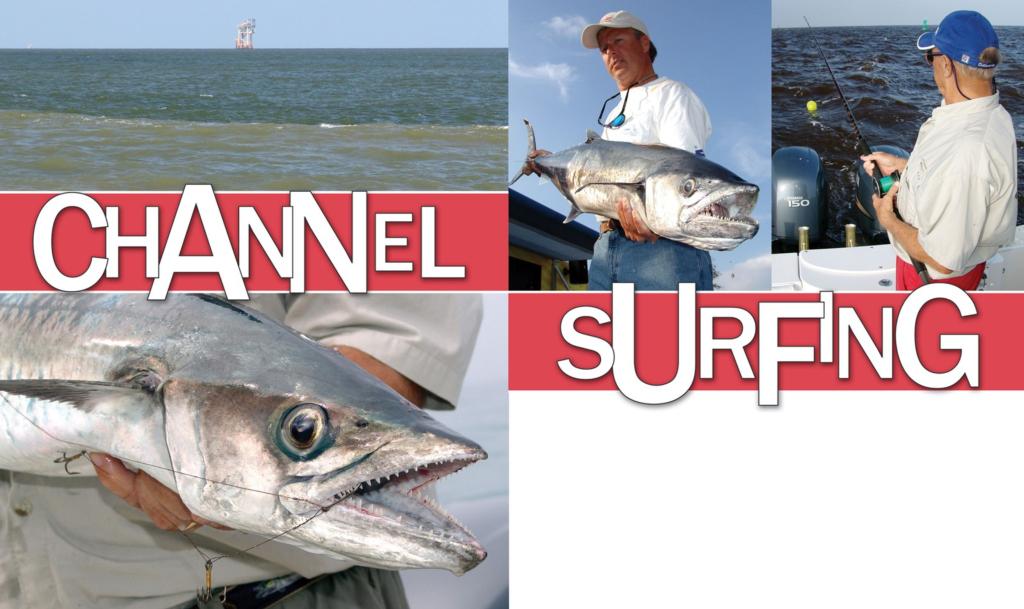
Channels have long been the salvation of kingfish anglers in no hurry to face the certain pounding of an angry sea. However, there’s plenty of reason to target these coastal arteries even when the weather’s fine.
By any description, channels accessing ports, rivers or harbors represent prime opportunities for predators such as king mackerel to intercept prey. Just look at the dynamics: a deep trench runs through a narrow portal where daily tidal flushing collects a bounty of baitfish into one massive food funnel.
In St. Petersburg, Fla., Wal-Mart FLW Kingfish Series competitor Robert Dawson, who is captain of Team Pork Chop, described it this way: “It’s a large flow of water and a large flow of bait in a concentrated area. Flow, flow, flow – that’s it.”
Compared to the commitment required for hunting prey in open water, kings probably consider channels sort of a cafeteria or drive-through-window deal. For anglers, blending rigged baits into this attractive availability can bring the slam-dunk or home-run strike that makes all the day’s effort worthwhile.
It sounds pretty simple – and it can be – however, a shot-in-the-dark approach will usually leave you with an empty feeling to match an empty fish bag. Here’s a look at some of the elements that turn channel fishing into channel catching.
Timing is everything
John Parks of Jacksonville, N.C., captain of Team Raymarine on the Wal-Mart FLW Kingfish Tour, regularly fishes in East Coast channels. When Parks and crew won the inaugural Wal-Mart FLW Kingfish Tour Championship out of Morehead City, N.C., in 2005, they secured one of their weight fish in the Beaufort Inlet channel. As was the case in his championship effort, Parks said channel fishing requires patience, persistence and a high tolerance for boredom.
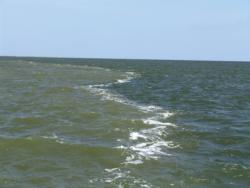 “It’s more of the one-shot deal,” Parks said. “It’s never really a high-productivity day, but when it’s the time to be there, there’ll be more than one good fish caught. You’ll get your shot – you may or may not capitalize on it – but you have a good chance of getting that big strike.”
“It’s more of the one-shot deal,” Parks said. “It’s never really a high-productivity day, but when it’s the time to be there, there’ll be more than one good fish caught. You’ll get your shot – you may or may not capitalize on it – but you have a good chance of getting that big strike.”
According to Parks, the right tide makes all the difference. In Carolina waters, 74 to 78 degrees is the ideal water-temperature range – particularly when that water has piled into an inlet and has just started heading back out.
“The kings are just sitting there waiting for the bait to start falling out of the channel,” Parks said. “When the tide (picks up), they just move on out with the water.”
Of course, too much of a good thing can be a bad thing, and that holds true for current. Essentially, moving water aids in the kings’ feeding, but when the flow becomes so intense that the fish expend too much energy fighting to maintain their mission, it’s time to move elsewhere.
“When the tide starts ripping, it seems the kings just aren’t in the channels so much,” Parks noted. “They move out toward the end of the channel, near the sea buoy.”
Prime time is usually brief, but sporadic opportunity may occur throughout the day. “You have just a small window of opportunity to fish it,” Parks said. “But like everything, there’s an exception to the rule. If bunches of fish are coming from in there, I may fish the channel all day.
“When the water’s topped out, the kings may be a mile inside the inlet. But as the tide starts falling, I’ll move on out into the channel and then out toward the sea buoy.”
The stronger water flow of new- and full-moon tides means maximum water movement and maximum bait congregation. Heavy water flow also intensifies the classic tide-line effect created primarily when an outgoing flow collides with existing water masses outside the inlet. Distinct differences in color and temperature, along with baitfish bunching, yield a powerful kingfish magnet.
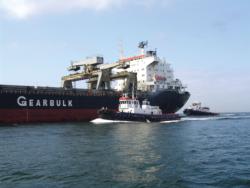 Although tide lines are less prominent along Florida’s western shores, the attraction is undeniable throughout the Atlantic seaboard. “On the Gulf Coast, a tide line is not as significant to kingfish anglers,” Dawson said. “On the East Coast, it’s the written rule. From blue-green, to two creams and a sugar – that’s what you look for. When a tide line comes across an artificial reef, if you can time it so you’re on the reef when the line crosses it, you’ll catch fish.”
Although tide lines are less prominent along Florida’s western shores, the attraction is undeniable throughout the Atlantic seaboard. “On the Gulf Coast, a tide line is not as significant to kingfish anglers,” Dawson said. “On the East Coast, it’s the written rule. From blue-green, to two creams and a sugar – that’s what you look for. When a tide line comes across an artificial reef, if you can time it so you’re on the reef when the line crosses it, you’ll catch fish.”
When kingfish anglers visit southern Louisiana, they find the Mississippi River’s multi-headed delta spinning tide lines in several directions. Lots of muddy river water rushing headlong into clean Gulf brine creates a bountiful feast extending several miles from the passes. Kings patrol close – occasionally busting threadfins, mullet and other local forage right along the Southwest Pass jetties.
“I’ve seen kingfish jump from the clean water into the dirty water to hit bait and then jump back,” Dawson said.
In his home waters of the greater Tampa Bay area, Dawson favors the front side of an incoming tide when the current piles baitfish along the edges of the Egmont Channel close to the bay’s Sunshine Skyway Bridge. As the tide rises, kings will often push well inside such inlets to round up baitfish, which have less room to run. No doubt, many a tournament-quality kingfish has tasted a treble hook inside Tampa Bay, as well as Boca Grande Pass, leading into Charlotte Harbor. Atlantic anglers know that monster kings hunt high-tide meals inside the turning basins of Port Canaveral and Morehead City.
On either coast, precipitation can be a party pooper. “A lot of times, if you’ve had a lot of rain, that freshwater flow will push the kings farther out,” Parks said.
Strategy points
As with any king mackerel scenario, channel-fishing variables are many. Key points include the following:
Stay near the food – “I like to see a lot of bait in the channels,” Parks said. “I’m looking for surface action (as well as marking bait on the depth recorder). As I move on out, I also like to see a lot of Spanish mackerel, because kings will eat those.”
Augmenting the natural forage attraction, aggressive chumming can help optimize a channel’s potential. Fool a big king into thinking he’s sniffed out a fresh bait pod, and the first mouthful he sees may be his last.
Of course, one man’s chum is, well, another man’s chum. In other words, a load of stinky stuff flowing through a tight area benefits anyone whose bait crosses a hungry fish. Don’t take it personally if someone slides up to the area and pops a check-casher in your chum slick. It’s all the luck of the draw, and your winning hand may come the following week.
Keep it clean – Invariably, the most consistent kingfish action will occur in the cleanest water. This is particularly relevant to tide lines, where a lateral move of 1 yard can take your bait from zero to hero.
As Dawson noted, extremely muddy water, such as that of the Mississippi River Delta, may hold a hidden opportunity. Dirty water will roll over the clean brine to create a layered effect. Observant anglers will pick up on this and respond accordingly.
Dawson simply checks his prop wash. “If your props kick up clean water in the muddy water, go with downrigger baits to get under the (dirty water),” he said. “That’s where the fish will be.”
Bigger baits and multibait rigs are always a good bet in areas of lower visibility, but Parks also believes in accessorizing with dusters, beads and the like. “I tend to go with a little more color and flash when the water’s a little dirtier,” Parks said. “Also, I’ll step up my wire from No. 4 to a No. 5 or a No. 6 just because the visibility is lower and we can get away with it.”
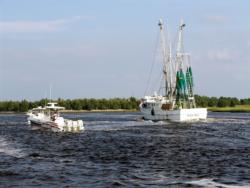 Keep it close – In channel situations, Dawson eliminates his shotgun bait (long flatline) and goes with two downriggers, a medium flatline and one in the prop wash. He sets all lines shorter than he does in open water.
Keep it close – In channel situations, Dawson eliminates his shotgun bait (long flatline) and goes with two downriggers, a medium flatline and one in the prop wash. He sets all lines shorter than he does in open water.
“There are usually a lot of boats nearby, so I usually tighten up my spread (in a channel),” Dawson said. “That makes it a more maneuverable spread so I can spin around if I want to. Plus, a shorter spread allows me to stay close and work the edge of a channel, instead of half the time having baits in clean water and half the time in dirty water.”
Watch Your Spacing – Ship traffic can complicate channel fishing, but recreational boats must yield the right of way – even when fighting a fish. Also beware the huge wakes of freighters, along with generally rough water caused by excessive traffic. For example, anglers fishing near the mouth of the Cape Fear River Channel at Southport, N.C., can plan on contending with pleasure boaters, freighters headed upriver to Wilmington, shrimpers traversing the waterway, and ferries running to and from Bald Head Island.
“The biggest challenge (of channel fishing) is all the obstruction – the buoys, the other boats and the ships,” Parks said. “When we get a strike, we turn around hard and get on the fish to keep him out of the buoys and to keep him clear of everything else that’s in there.”
Despite these concerns, channels represent considerable kingfish opportunity. Be prepared to play the waiting game, but when favorable conditions align, you won’t want to be anywhere else.
Bait plan
The same forage abundance that attracts big kingfish also facilitates the requisite bait-gathering mission that precedes a tournament day. At daybreak, dimpling bait schools, white-water commotion and diving birds can all lead you to the finned ammunition.
With the latter, pelicans are often the most visible with their dive-bombing style of feeding. However, not everything the long-beaked aviators eat is worth pursuing. Watch the pelican’s post-dive reaction – if a bird clears the water and immediately throws his head back to swallow, he’s eating big baitfish. If a 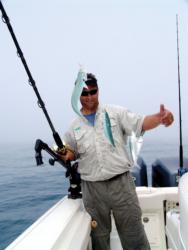 pelican hits and slowly raises his head, he’s straining out a bunch of tiny baits such as anchovies or sardines.
pelican hits and slowly raises his head, he’s straining out a bunch of tiny baits such as anchovies or sardines.
Cast netting is a viable option along beaches or shallow flats adjacent to a channel, but for nabbing the blue runners, cigar minnows, threadfin herring and Spanish sardines you’ll find around markers and throughout the deep-water environments, gold-hook sabiki rigs are most effective.
Ideal for quick response to sudden bait-school appearances, sabikis also allow for multiple anglers to probe different areas in response to what the helmsman sees on the bottom machine. Jerry Tumbleston of the South Carolina-based Team Bitta Sweet on the Wal-Mart FLW Kingfish Tour likes to tip his larger sabikis with cut shrimp. This attracts larger baits and makes the effort more productive for kingfish pursuits.
While trolling for kings, keep a sabiki rod in a rod holder and let the boat’s rocking action “work” the rig for impromptu bait location. Likewise, casting and trolling small spoons, Got-cha plugs or jigs while kingfishing can boost your bait supply with bluefish, ladyfish and Spanish mackerel.
Also, fishing in and around a channel makes it easy to re-bait. Live bait is crucial to tournament kingfishing, but fresh live bait often makes the difference between a look and a strike. Like all predators, kings respond most aggressively to prey that appears healthy, active and completely terrified. Weak, sluggish baits are like undercooked pizza – soft, limp and not very appetizing.
Dumping your baitwell during the midday slump and reloading with perky baits puts you in the optimal state of readiness.
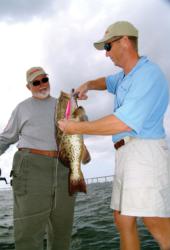
Side dishes
The free-for-all food fest associated with coastal channels attracts many predators in addition to kingfish. Smaller Spanish mackerel and bluefish make great smoker baits, but some of these toothy bycatch species will push well past rigging dimensions and right into table fare. Don’t be surprised to reel in ambitious mackerel and big blues that just couldn’t resist a vulnerable sardine, pogy or blue runner.
Tuna, small dolphin and cobia also frequent channels, and gag grouper take up permanent residence along the rocky walls. Particularly in Boca Grande and Tampa Bay’s Egmont Channel to the north, keeper gags find comfortable digs where years of tidal carving have left caves, ledges and undercut edges that offer tidal breaks and ambush points.
You can’t anchor in the channels, and setting up shop right along the edge can get risky, but securing a fresh grouper bonus is just as simple as swapping the fast-action, soft-tip kingfish rods and high-speed reels for stout boat rods with 4/0 reels and 50-pound braided line – the ideal gear for trolling big-lipped diving plugs right along the channel boundaries.
In addition to the food fish, kingfish channels sometimes attract top-shelf game fish for catch-and-release fun. Sailfish have been known to whack at bait schools hovering near sea buoys, while tarpon are keen to take their share of tide-funneled bait schools.
Boca Grande Pass at the mouth of Charlotte Harbor on Florida’s west coast sees kingfish rubbing elbows with the other “silver king” – tarpon – during the spring migrations. Most of the kingfishing action occurs seaward of the pass. However, the right tide can spark a furious king bite well inside the tarpon zone.
When deploying stinger-rigged live bait inside Boca Grande Pass, remember the local regulations. In an effort to ease tensions among multiple boats fishing in close proximity, the Florida Fish and Wildlife Conservation Commission restricts the number of fishing lines used in Boca Grande Pass to three per vessel for all species during April, May and June.